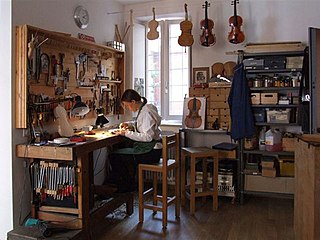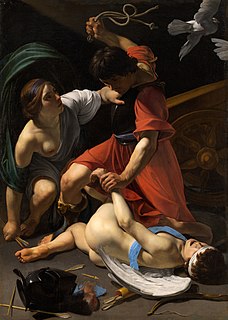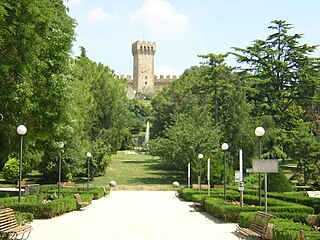Related Research Articles

A lute is any plucked string instrument with a neck and a deep round back enclosing a hollow cavity, usually with a sound hole or opening in the body. It may be either fretted or unfretted.

The viol, viola da gamba, or informally gamba, is any one of a family of bowed, fretted, and stringed instruments with hollow wooden bodies and pegboxes where the tension on the strings can be increased or decreased to adjust the pitch of each of the strings. Frets on the viol are usually made of gut, tied on the fingerboard around the instrument's neck, to enable the performer to stop the strings more cleanly. Frets improve consistency of intonation and lend the stopped notes a tone that better matches the open strings. Viols first appeared in Spain in the mid-to-late 15th century, and were most popular in the Renaissance and Baroque (1600–1750) periods. Early ancestors include the Arabic rebab and the medieval European vielle, but later, more direct possible ancestors include the Venetian viole and the 15th- and 16th-century Spanish vihuela, a six-course plucked instrument tuned like a lute that looked like but was quite distinct from the four-course guitar.

A luthier is a craftsperson who builds or repairs string instruments that have a neck and a sound box. The word "luthier" is originally French and comes from the French word for lute. The term was originally used for makers of lutes, but it came to be used already in French for makers of most bowed and plucked stringed instruments such as members of the violin family and guitars. Luthiers, however, do not make harps or pianos; these require different skills and construction methods because their strings are secured to a frame.

The Caravaggisti were stylistic followers of the late 16th-century Italian Baroque painter Caravaggio. His influence on the new Baroque style that eventually emerged from Mannerism was profound. Caravaggio never established a workshop as most other painters did, and thus had no school to spread his techniques. Nor did he ever set out his underlying philosophical approach to art, the psychological realism which can only be deduced from his surviving work. But it can be seen directly or indirectly in the work of Rubens, Jusepe de Ribera, Bernini, and Rembrandt. Famous while he lived, Caravaggio himself was forgotten almost immediately after his death. Many of his paintings were reascribed to his followers, such as The Taking of Christ, which was attributed to the Dutch painter Gerrit van Honthorst until 1990.

Stefano Landi was an Italian composer and teacher of the early Baroque Roman School. He was an influential early composer of opera, and wrote the earliest opera on a historical subject: Il Sant'Alessio (1632).

Este is a town and comune of the Province of Padua, in the Veneto region of northern Italy. It is situated at the foot of the Euganean Hills. The town is a centre for farming, crafts and industry worthy of note.
The city of Venice in Italy has played an important role in the development of the music of Italy. The Venetian state—i.e. the medieval Maritime Republic of Venice—was often popularly called the "Republic of Music", and an anonymous Frenchman of the 17th century is said to have remarked that "In every home, someone is playing a musical instrument or singing. There is music everywhere."
Giovanni Girolamo Kapsperger was an Austrian-Italian virtuoso performer and composer of the early Baroque period. A prolific and highly original composer, Kapsberger is chiefly remembered today for his lute and theorbo (chitarrone) music, which was seminal in the development of these as solo instruments.

Gasparo Duiffopruggar was an instrument maker. His originally German family name was also spelled Tieffenbrucker, Tiefenbrugger, Tiefenbrucker, Teufenbrugger, Tuiffenbrugger, Deuffenbrugger, Dieffopruchar, Dieffoprughar, Duyfautbrocard, Duiffopruggar, Duiffoprugcar, Dubrocard, Dieffoprukhar, Diafopruchar, Thiphobrucar, Fraburgadi, his first name also Kaspar, Caspar or Gaspard. Duiffopruggar is believed to have been born near Füssen in Bavaria, Germany, and had moved to Lyon, France, where he did most of his work, by 1553. He was one of the first to produce the violin in its modern form.
Jeronimo Bassano was an Italian musician in the Republic of Venice who is notable as the patriarch of a family of musicians: five of his sons, Anthony, Alvise, Jasper, John (Giovanni), and Baptista Bassano, moved from Venice to England to serve in the court of King Henry VIII. They performed as a recorder consort. Jacomo Bassano was his only son to keep his primary residence in Venice. Jeronimo Bassano never moved, and he was listed in Venice as a "Maestro of the trumpets and shawms." He is believed to be the maternal grandfather of composer Giovanni Bassano.

The lira da braccio was a European bowed string instrument of the Renaissance. It was used by Italian poet-musicians in court in the 15th and 16th centuries to accompany their improvised recitations of lyric and narrative poetry. It is most closely related to the medieval fiddle, or vielle, and like the vielle had a leaf-shaped pegbox with frontal pegs. Fiddles with drone strings are seen beginning in the 9th century, and the instrument continued to develop through the 16th century. In many depictions of the instrument, it is being played by mythological characters, frequently members of angel consorts, and most often by Orpheus and Apollo. The lira da braccio was occasionally used in ensembles, particularly in the intermedi, and may have acted as a proto-continuo instrument.

Pietro Paolini, called il Lucchese was an Italian painter of the Baroque period. Working in Rome, Venice and finally his native Lucca, he was a follower of Caravaggio to whose work he responded in a very personal manner. He founded an Academy in his hometown, which formed the next generation of painters of Lucca.

Silvestro di Ganassi dal Fontego, also given as Sylvestro di Ganassi dal Fontego, Silvestro Ganasi dal Fontego, and Silvestro dal Fontego was a Venetian musician and author of two important treatises on instrumental technique.
The Scuole Grandi were confraternity or sodality institutions in Venice, Italy. They were founded as early as the 13th century as charitable and religious organizations for the laity. These institutions had a key role in the history and development of music. The first groups of bowed instrument players named Violoni were born there in the early 16th century.
The Lupo family was a family of court musicians in England in the 16th and 17th centuries. "Lupo", Italian for "Wolf", was often used as a surname by Jews in Gentile society. Per Holman, "It must have appealed to them as a suitably ironic name for a persecuted people who were often likened to wolves in the mythology of the time."
Ambrose, Ambrosius or Ambrosio Lupo was a court musician and composer to the English court from the time of Henry VIII to that of Elizabeth I, and the first of a dynasty of such court musicians. He is thought to have been born in Milan, though he and his family lived in Venice for a while just before being called to England. He and five other viol players, including Alexandro and Romano Lupo, were summoned to England by Henry in November 1540, to bring English music up to speed with music on the continent. Ambrose, also known as 'Lupus Italus' and de Almaliach, was the longest-serving of the group.

Bartolomeo Veneto was an Italian painter who worked in Venice, the Veneto, and Lombardy. During his time in Venice, he studied under Gentile Bellini. The little information available about Bartolomeo's life has been derived from his signatures, dates, and inscriptions. His best-known works are portraits or pictures with portrait-like character. Bartolomeo's later works, and especially those done on commission in Milan, indicate an influence from the artist Leonardo da Vinci.
Joan Maria da Bressa was a Brescian lyre maker active in Venice in the first decades of the 16th century. One of the best lyres in the world made by him, with a very fine decorated and gilt head (palette) dated around 1525 by David Boyden, but more probably of the middle of the century, is now in the Ashmolean Museum in Oxford. Some scholars claim that he was the father of Giovan Giacomo Dalla Corna. A Zuanmaria de Antonio Bressan dai violini is found in some venetian documents dating from 1562 to 1601 testifying his work also like a maker of violini, lire e lironi. Another man with similar name is Joan Maria Dalla Corna, father of Jo Jacobo Dalla Corna, a brescian maker born around 1484.
Isola di San Clemente is a small island in the Venetian Lagoon in Italy. For centuries it housed a monastic settlement, and more recently an asylum. It is now the site of a luxury hotel.
Matteo Sellas was a German luthier born in 1580 in Füssen who worked in Venice from 1620–1650 and is best known for building lutes, archlutes and baroque guitars.
References
- Lundberg, Robert (2002). "Historical Lute Construction" ISBN 0-9626447-4-9
- "THE TIEFFENBRUCKER FAMILY and its collaborators" pp. 262 - 343, book "Viol and Lute Makers of Venice 1490 -1630" by Stefano Pio, Venice 2012, Ed. Venice research. www.veniceresearch.com